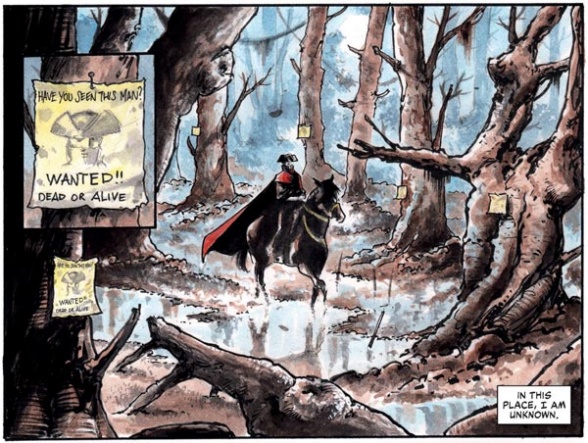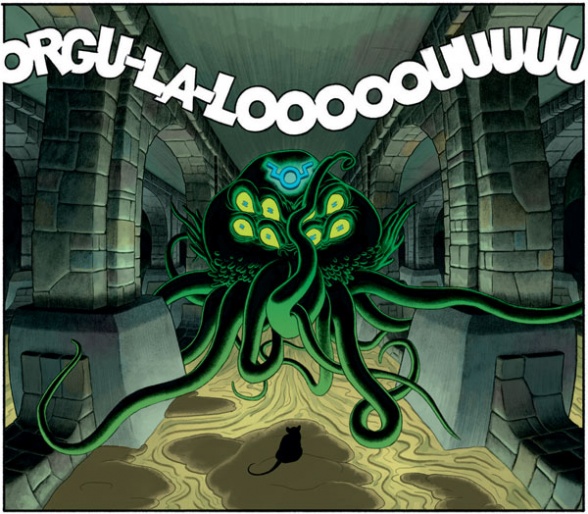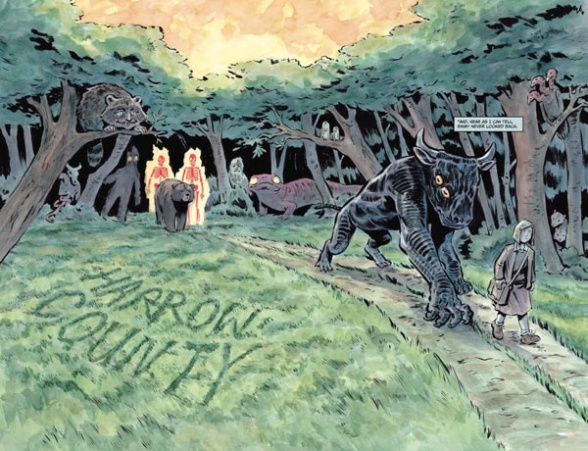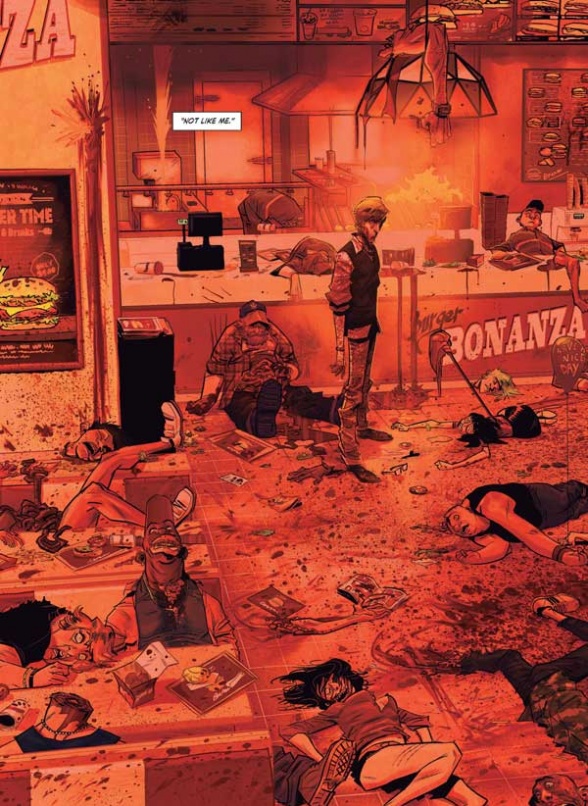Cullen Bunn is one of the busiest comics writers out there. Just looking at the list of titles he’s got coming out from July to September, it’s spectacularly huge. So for our interview with him today we’re narrowing our focus to just the stuff he’s got coming out from Dark Horse Comics: “Parasomnia,” a “Black Hammer: Visions” one-shot, “Tales from Harrow County: Fair Folk,” and “Lucky Devil.” Yeah, even from only one publisher, it’s still quite a few titles.
Parasomnia
Written by Cullen Bunn
Illustrated by Andrea MuttiFrom Cullen Bunn (Harrow County) and Andrea Mutti (Prometheus, Starship Down), comes a new dark fantasy tale of two worlds split between dreams and reality.
After his son disappears, a broken-down man braves a nightmarish dreamscape in order to find him—and battle the ruthless cult that seeks to rule the land of dreams as the barrier between realities starts to collapse.
“Parasomnia” deals with a man living two lives, one real, the other seemingly a dream, and both seem to echo aspects of each other. The marketing I’ve seen describes the main character as captive to the dreamscape. What is it that made you want to tell a story about taking the realm of dreams, normally a place of escapism, and turn it into a prison?
Cullen Bunn: You know, dreams have never been a source of escape for me. Yes, I’ve had good dreams, but those that really stick with me tend to be nightmares, big and small.

So, yeah, nightmares. And I don’t think I have much control over them. When I go to sleep, it’s my subconscious that takes the wheel. And no one wants that. No one.
Andrea Mutti’s art seems like such a perfect match for the subject matter here, both dreamlike and melancholic. It’s immediately such a natural fit for the premise, I have to wonder which came first. Did Mutti want to try a style that suggested a story to you or did Mutti push certain aspects of his style as the premise evolved?
CB: Andrea and I had been trying to find a book that might work for us. I had sent him a few different concepts, and we were even working on developing a couple of them. At some point, though, I had this idea for the book that would become “Parasomnia.” Maybe I was inspired by his art style. Either way, I sent it along to him, and he immediately sparked to it.
You’ve mentioned in interviews before that you’d like to write Solomon Kane, so I can’t help but wonder if a little bit of “Parasomnia” is about scratching that itch so to speak.
CB: Ha! Yes! Absolutely! When I started brainstorming “Parasomnia,” one of my motivations was that I figured I’d never be given the chance to write Solomon Kane, a character I dearly love. So, I decided to create a character of my own that would satisfy those interests.
Weirdly enough, after I started working on “Parasomnia,” I was contacted to write a Solomon Kane comic. Working on “Parasomnia” helped to guide me in some new and different directions for the Kane book. I wrote three issues of Kane. One was drawn. But the book was cancelled before it came out thanks to the pandemic.

In the parallel realities of “Parasomnia,” the main character is searching for his son. Am I right in assuming this tale explores what can happen to a person in a desperate situation when they feel powerless?
CB: For sure. With “Parasomnia” I wanted to explore this idea of a man who was powerless in the waking world. He’s lost everything and there is nothing he thinks he can do about it. In the world of dream, though, he has power. He can manifest his will in dreams. The problem he faces, of course, is that his subconscious can turn against him at any time. So, searching for a missing child in his dreams will lead him on a journey through many, many different realms.
Continued belowThe plan for “Parasomnia” is a series of miniseries, each one working as a piece of a much larger puzzle, each one getting weirder and weirder as the overarching tale progresses.
I like the sound of that.
“Parasomnia” #1 is out now. Issue #2 comes out next week, July 28.
Black Hammer: Visions #6
Written by Cullen Bunn
Illustrated by Malachi Ward & Matt Sheean
Colored by Dave Stewart
Lettered by Nate PiekosAfter rejecting the calls of a dark god and his rat emissary beneath the sewers of Spiral City, Cthu-Lou’s favorite television program is interrupted by an underground cult and their world-ending horror machine.
So how did this series come about? Clearly, “Black Hammer” creators Jeff Lemire and Dean Ormston thought it would be fun to invite other creators to play in their universe, but how do we get from that to you writing a story about Louis Kaminski, a plumber infested by a sewer-dwelling elder god?
CB: Jeff and my editor at Dark Horse, Daniel Chabon, reached out and asked if I’d be interested in contributing to the project. I’m a huge fan of the universe Jeff created, so I immediately agreed. At that point, I didn’t have a character to focus on. Daniel asked me to think on it a few days and get back to him. It didn’t take me long to land on a Cthu-Lou story idea. I love Lou’s eldritch horror vibes and working class style. I wrote up a quick idea (a paragraph or so) and sent it to Jeff and Daniel, and we were off to the races.

You’ve written for licensed properties and company-owned comics before, so you’re used to playing in someone else’s sandbox, but in this case you’ve been invited into a creator-owned universe with more of an indie sensibility. Did that change the way you approached the material at all?
CB: Probably a little. Maybe more than that, I consider Jeff a friend, and I stressed quite a bit on him being pleased with how this book turned out. I didn’t want to let him down.
Are there any story or character points from Cthu-Lou’s previous appearances in “Sherlock Frankenstein and the Legion of Evil” or “Black Hammer: Cthu-Louise” that particularly got you excited about writing him?
CB: Both stories were inspirational, but it was the Cthu-Louise story that really served as the springboard here. Keep in mind, this tale takes place before Cthu-Louise is born, but the feel and style of the story comes from that book, I’d say.

If you were invited back for more “Black Hammer” stories, what other characters and corners of this world would you like to explore?
CB: More Cthu-Lou! But others that appeal to me (meaning I think I could tell an interesting story about them) include Colonel Weird, Sherlock Frankenstein, and Skulldigger.
“Black Hammer: Visions” #6 is out now.
Tales from Harrow County: Fair Folk
Written by Cullen Bunn
Illustrated by Emily Schnall
Lettered by Tyler CrookHarrow County is back! The award-winning, Eisner-nominated southern-gothic horror series returns with a brand-new story.
Fresh off the loss of her goblin friend to a strange portal, Bernice must weigh her responsibilities as protector of Harrow County with her desire to get her companion back safe and sound. But the past weighs heavily and the fair folk use Bernice’s and her memories against her. And something more disastrous than she could have feared may be around the corner to threaten both the worlds of humans and of haints.
From what I understand, unlike “Harrow County,” which was one long sprawling story, arcs of “Tales from Harrow County” are able to stand alone, even though there are still continuing story elements. Does this present challenges and opportunities for you didn’t experience while working on “Harrow County”?
CB: Yeah. It’s not easy. Especially when a story like ‘Fair Folk’ is a direct sequel to ‘Death’s Choir.’ But I try to make every chapter have its own look and feel. ‘Death’s Choir’ was a more traditional horror yarn. ‘Fair Folk’ leans more into the fairy tale aspects of “Harrow County.” The real question, of course, is who said this wasn’t part of one long, sprawling story?
Continued belowI like the sound of that.
I think it’s fair to say that not just any artist can do a “Harrow County” story. There’s a certain look, and an approach to character and pacing that feels essential. So when you were looking for an artist for “Tales from Harrow County: Fair Folk,” what were you looking for? And when you found Emily Schnall, what was it that she brought to the project that was distinctively hers?
CB: You’re absolutely right. The artistic style of a “Harrow County” story is essential. For me, the most important guideline is that the art needs to look as if it is part of the same “family” of art Tyler Crook created for the book. And that’s a tall order. Emily absolutely fits the bill. While her style is unique to her, we could see it working in the “Harrow County” universe. Her character work is so charming and wonderful, and her creatures are weird and disturbing. Emily had a challenge ahead of her, too, as she is heavily involved in designing a new batch of beasts.

This arc is called ‘Fair Folk’ and yet almost all of Emily Schnall’s and Tyler Crook’s covers for the first three issues are wrapped in black—even for “Harrow County,” having so many predominantly black covers back to back is rare. Clearly, this isn’t the usual fairy kingdom of glowing lights we’re used to, and what lies ahead for Bernice, Georgia, and Priscilla is something outside the usual “Harrow County” purview.

CB: No, this is probably not what readers expect from a fairy tale, and it is definitely treading a path we have not seen in a “Harrow County” story thus far. Fairy tales can be frightening. Dealings with the fair folk can be unpredictable and dangerous. We’re in uncharted territories here. In the end, this book will have a major impact on the world of “Harrow County.”
I know the pandemic drew out the wait for this next series longer than you intended, but leaving Priscilla’s fate unknown for so long was brutal. Then Tyler went and did that heartbreaking variant cover for issue #2. So I guess my question is, are you enjoying hurting us?
CB: Enjoy it? Never. But it’s necessary. And maybe it warms my heart. Why would such a thing bring me warmth? Well. . . if you’re worried about the characters, it means you care about them, and that’s really all I want. And if you think the wait has been tough between ‘Death’s Choir’ and ‘Fair Folk,’ you’re going to be in big trouble waiting for what comes next.
“Tales from Harrow County: Fair Folk” #1 comes out this Wednesday, July 21.
Lucky Devil
Written by Cullen Bunn
Illustrated by Fran Galán
Lettered by El TorresA down-on-his-luck schlub is possessed by a malevolent demon. Just when he thinks things can’t get worse, the exorcism goes wrong. . . and he finds that somehow he’s retained all of the entity’s supernatural gifts. After a path of revenge on all the people that have wronged him, he begins to gather worshippers and form a cult.
But the legions of Hell don’t take kindly to this, and they send demonic agents to murder the schlub-turned-god before he gains too much power.
This is a story where the pitch won me over at once—Stanley gets possessed by a demon, and after a botched exorcism, he ends up with demonic powers sans demon. That actually sounds pretty good, except that this has really pissed off the residents of Hell. To me, it’s a premise that promises a lot of fun. And the three-page preview of Fran Galán’s art looks awesome. What prompted this story?
CB: I don’t know where this one came from, to be honest. I wanted to do another book with Fran, and I had this idea that he’d do an amazing horror comedy. With that in mind, I sat down with my trusty notebook and started brainstorming ideas. Somewhere along the way, I jotted down the idea of a powerless guy getting vast, infernal power. What would he do with that power? What would he gain? What would it cost him? And that blossomed into the core concept for this book.
Continued below
I heard the original title for this one was “Hail Stanley,” which is great, by the way. Please tell me this title still at least survives as an arc title.
CB: Yes, for the longest time, this book was called “Hail Stanley” or “Hail… Stanley?” That’s how I pitched it to publishers. But the fine folks at Dark Horse felt that the book might do a little better sales-wise if the title was a little more direct. They were right, of course. But I wanted to keep “Hail Stanley” in some way, so the arc title remains. Same thing happened with “Countless Haints” and “Harrow County.”
You’ve said this is a dark comedy, and from some interviews it sounds like it could potentially get really dark. Do you find it a tricky line to walk tonally?
CB: It definitely gets very dark in places. When I look back over this first series, there’s only one or two spots that I wonder if I went too far. Usually, that means the horror went too far. We’ll see. The key for me here is to never play the horror elements for laughs. The way people react might be humorous, but the horror never is. And I never really get into, say, slapstick comedy. It’s a little more grounded than that. More realistic, I hope, because the world is a funny place, even when everything is going south.

I think one thing this interview should have impressed upon our readers is the variety of tones you have to shift through as you write on these different books (and this is only your stuff at Dark Horse!) So can you talk a little about how you manage changing gears as you jump from one project to another? Do you have ways to get yourself into the headspace of a particular comic?
CB: My hope is that every book is so well-defined in terms of the concept and tone that I don’t need to really think about it. Now, sure, there are times when I need to sit back and refocus before starting a project. That might include reading something that has a similar tone to what I’ll be going for, maybe listening to some music to set the mood. More often than not, though, it is the outlining process that really cements the tone of the issue I’m writing. As I go through several different outlines, the book becomes more and more tangible for me. It takes shape and becomes its own thing. Sometimes, it becomes something I wasn’t expecting, but that’s all part of the process!
Look for “Lucky Devil” #1 when it comes out August 4.







